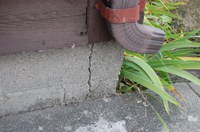Dry Soil May Cause Structural Problems
(Click the image below to view a high-resolution image that can be downloaded)
The drought not only affects crops and plants. It also may cause problems for your home.
“Sticking doors or windows and cracks in walls or ceilings may be indications that the building is shifting due to soil shrinkage,” says Ken Hellevang, North Dakota State University Extension Service agricultural engineer.
As clay or other fine-particle soils dry, they shrink, creating gaps around the basement wall. This space exposes more of the soil to airflow, which increases the amount of moisture removal. A gap along the wall, through time, may allow airflow that will dry the soil under the foundation. The foundation’s support is removed as the soil shrinks, which may stress the concrete enough to cause a crack to form.
This also will occur around concrete slabs if the support base is clay or other fine-particle soil that swells and shrinks with changes in moisture content, according to Hellevang.
The gap between the soil and basement wall also allows water from rain to run down the wall and may result in water seeping into the basement.
To minimize these problems, Hellevang recommends maintaining a relatively constant moisture content in the soil around the house. Water the soil evenly around the entire foundation during extended dry periods if the soil is pulling away from the basement wall.
“Do not apply water directly into the gap because this may cause water intrusion into the basement,” he says. “Instead, apply water 1 to 2 feet away from the foundation edge. A soaker-type hose permits applying water to the soil without getting it on the house wall. Apply the water slowly with rest periods of several hours to permit the water to gradually soak into the soil to a depth of several feet.”
Sometimes people place plastic under rock next to the house as part of landscaping or to minimize water infiltration next to the house. This will prevent you from applying water next to the house. However, water added to the soil even 3 feet from the wall will migrate through the soil profile and wet the soil near the basement wall. It likely will not migrate enough to close the crack or gap near the surface, but it will wet the soil at greater depths and minimize the potential for soil shrinkage that may affect the structure.
“Do not fill the crack next to the basement wall with soil,” Hellevang says. “When the soil gets wet, it will expand, pushing on the basement wall, possibly with enough pressure to crack the wall.”
Even if cracks have appeared in walls or doors are sticking, you should apply water now to keep the soil from drying further and to rewet the soil to a normal level.
Because keeping the soil at a relatively constant moisture content is the goal, having a drainage system to remove excess moisture also is important. This includes making sure you have drainage pipe that’s encased in granular material along the footing and a drainage plane along the exterior of the basement wall.
You generally can use the size of the cracks in the basement walls to determine if you need to hire a contractor to repair the foundation or basement.
Hellevang suggests you also look for changes in alignment by sighting along the length of the wall to see if it is straight. Alignment problems are more common with soil expansion, but they also can occur when the wall is not supported laterally due to the soil shrinking away from the basement. The amount of distortion in alignment can be used to determine the need for a contractor.
Cracks in the basement wall should be repaired to reduce the potential for water intrusion. You should wait to repair cracks in other walls and ceilings until the soil moisture returns to normal.
“Remember that if the crack occurred due to soil shrinkage, the soil will expand when it gets wet,” Hellevang says.
Problems with doors and windows binding may correct themselves when the soil expands as it gets wet.
NDSU Agriculture Communication - Aug. 26, 2013
| Source: | Ken Hellevang, (701) 231-7243, kenneth.hellevang@ndsu.edu |
|---|---|
| Editor: | Ellen Crawford, (701) 231-5391, ellen.crawford@ndsu.edu |


